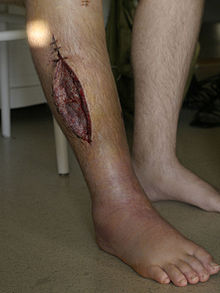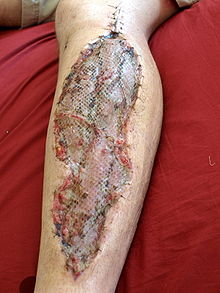User:Clc64/sandbox
This article needs additional citations for verification. (July 2012) |
| Fasciotomy | |
|---|---|
| ICD-9 | 82.12 83.14 |

Fasciotomy or fasciectomy is a surgical procedure where the fascia is cut to relieve tension or pressure commonly to treat the resulting loss of circulation to an area of tissue or muscle.[1] Fasciotomy is a limb-saving and can be a life-saving procedure when used to treat acute compartment syndrome. It is also sometimes used to treat chronic compartment stress syndrome when rest fails to relieve symptoms or is not optional due to athletic commitments. The success rate for chronic compartment fasciotomy has an average of 81% according to a study performed [2] The procedure has a very high rate of success, with the most common problem being accidental damage to a nearby nerve.

Complications[edit]
A delay in performing the procedure can lead to neurovascular complications or lead to the need for amputation of a limb.[1] Complications can also involve the formation of scar tissue after the operation. A thickening of the surgical scars can result in the loss of mobility of the joint involved. This can be addressed through occupational or physical therapy. Another complication could include the fasciotomy failing and needigng to be conducted again. For athletes suffering from chronic compartment syndrome, the reoccurance rate is between six and eleven percent[3]
Process[edit]
Fasciotomy in the limbs is usually performed by a surgeon under general or local anesthesia. An incision is made in the skin, and a small area of fascia is removed where it will best relieve pressure. Oftentimes, more than one area of each fascia is released to best results.
Plantar fasciotomy is an endoscopic procedure. The physician makes two small incisions on either side of the heel. An endoscope is inserted in one incision to guide the physician. A tiny knife is inserted in the other. A portion of the fascia near the heel is removed. The incisions are then closed. Compartment syndrome fasciotomy varies depending on the type of compartment syndrome and the location. Acute compartment syndrome typically happens in the arms, legs, or abdomen. In the lower leg the incision is usually from just below the knee and just above the ankle on both the lateral(outside) and medial(inside) of the leg in order to perform the fasciotomy in all four compartments-anterior(front), lateral, superficial posterior(back), and deep posterior. Through those incisions, the fascia can be also be cut, releasing the built up pressure in the compartments. In a thigh fasciotomy an incision in the skin will expand on the lateral side of nearly the whole thigh. In the forearm the incision is an "S" shape beginning in the center, near the the hand and ending in distal area near the elbow [3]. With abdominal compartment syndrome many different techniques can be used. The first is using an incision from a recent previous surgery. The most common technique used is making the incision is vertically along the midline of the abdomen. Another common technique is making bilateral subcostal(under ribs) incision[4]. In most acute compartment syndrome fasciotomy procedures the incisions are left open and covered with a sterile dressing for a period of time to allow the swelling and pressure to go down. Then, typically 3-7 days later, the incision is brought together either by sutures or a skin graft depending on the severity. Chronic compartment syndrome is handled very similarly to acute compartment syndrome. The lower legs are the most common area chronic compartment syndrome occurs and therefore, the most common place for a fasciotomy. Arms are the area of the body that can be affected by chronic compartment syndrome. For the lower legs, incisions are made laterally and/or medially, depending on which compartments need to be released. Since this is not an emergency procedure, the compartments should not be swollen allowing the surgeon to make a smaller incision than those suffering with acute compartment syndrome [4]

In addition to scar formation, there is a possibility that the surgeon may need to use a skin graft to close the wound. Sometimes when closing the fascia again in another surgical procedure, the muscle is still too large to close it completely. A small bulge is visible, but is not harmful. It takes much time to heal and in some cases takes several months.
Indications[edit]
While not many different diseases or syndromes require a fasciotomy, for some it is the only cure. It may be needed for those with plantar fasciitis, compartment syndrome-acute or chronic,-or Dupuytren's contracture. All of these, with the exception of acute compartment syndrome, have conservative treatments which are generally tried before receiving the fasciotomy [5].
See also[edit]
References[edit]
- ^ a b Dente CJ, Wyrzykowski AD, Feliciano DV (October 2009). "Fasciotomy". Current Problems in Surgery. 46 (10): 779–839. doi:10.1067/j.cpsurg.2009.04.006. PMID 19735797. Retrieved 2012-07-30.
{{cite journal}}: CS1 maint: multiple names: authors list (link) - ^ Am J Sports Med. February 2013. Functional outcomes and patient satisfaction after fasciotomy for chronic exertional compartment syndrome. NCBI.
- ^ Tucker, Alicia K. October 2010. Chronic exertional compartment syndrome of the leg. NCBI.
- ^ Wood, Jennifer MD. October 8, 2013. Fasciotomy. Medscape.
- ^ NHS. July 25, 2013. Dupuytren's contracture - Treatment
